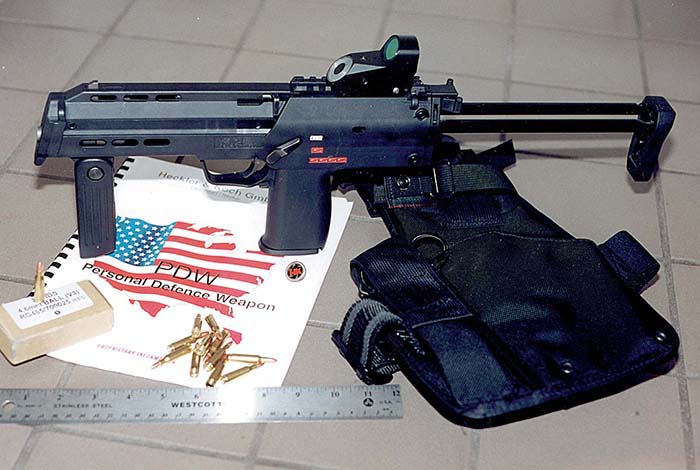By Jim Schatz
The long touted arrival of the year 2000 marks the fiftieth year of existence for Heckler & Koch GmbH. Though actually incorporated in late December 1949, HK did not start actual production of product, at that time precision-machined parts for sewing machines, until 1950, almost ten years before they produced their first series-production firearm. In its relatively short existence as a small arms design and production firm, Heckler & Koch has earned a reputation for innovation in the design and production of advanced military, law enforcement and sporting firearms and accessories for the discriminating user. Few firearms companies can brag about their accomplishments in the last half of the 20th century in the way that HK can, though chooses not to.
The Heckler & Koch 7.62 mm G3 rifle was at one time the second most commonly encountered assault rifle in the world, second behind the ubiquitous Kalashnikov AK47/AKM. More than 80 nations selected the G3 to outfit their Armies. In fact the German Army still uses the G3 today though many forward-deployed units have transitioned to the newer 5.56mm HK G36 rifle and carbine. The design of the G3 spawned an entire family of small arms employing the proven and unique delayed roller-locked bolt system, a common feature of most early HK’s weapons, to include even the HK P9S handgun. The technology to produce complete firearms, save the barrel and bolt, from metal stampings and in modular assembly groups for decentralized assembly was not pioneered by HK but was certainly exploited to near perfection by the Oberndorf gun maker. Today HK has replaced sheet metal stamping and welding with injection polymer molding and powdered metal technology in the design and production of their newest products, like the UMP submachine gun and G36 assault rifle.
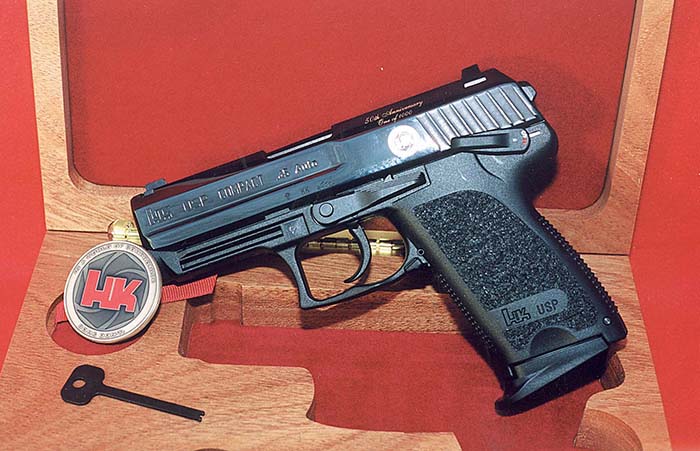
A short history lesson
Two former Mauser engineers, Edmund Heckler and Theodor Koch founded Heckler & Koch along with a third member, Alex Seidel. Messrs. Heckler & Koch had worked for the Mauser Werke factory, also located in the town of Oberndorf, Germany , along the Neckar river, before and during the Second World War and participated in the design of the GerotO6H rifle and later the StG45(M) assault rifle which employed an early rendition of HK’s famed roller-locked bolt. After the war this operating system reappeared in an early Spanish CETME rifle and then returned to HK’s hometown by the mid-1950’s to be refined by into the G3 rifle, adopted by the new German Army in September of 1959. Heckler & Koch got its start in wooden barracks once used during the Second World War for housing the work force for the Mauser Werke factory. Though today only one of these buildings remains, retained as a historical landmark. The modern design and production facility that is HK GmbH today is among the finest and most technically advanced in the world.
A Gun for Every Purpose
Since 1959, Heckler & Koch has developed and produced an astonishing array of small arms in nearly every category and caliber up to and including 40mm, and in using most of the methods of operation and breech locking known to man. HK’s have been designed in no less than 30 different calibers from .22 Long Rifle through the devastating 40X53mm High Velocity cartridge capable of delivering a high explosive fragmentation grenade to targets at ranges out to 2,200 meters. Small arms produced by Heckler & Koch have weighed as little as a few ounces to more than 57 pounds, and have used gas operation and gas retardation, short and long recoil, simple and delayed blowback with and without advanced primer ignition, manual operation with mechanical, gas and hydraulic buffers, mechanical and even electrical primer ignition. All methods of operation, recoil mitigation and cartridge ignition are employed in one or more HK firearm over the past 40 years. The chambers of HK firearms have been locked using rotating, spinning, revolving, rising or linear locking bolts, fixed, tilting and rotating barrels and bolts and slides locked by means of lugs, rollers, pins and simple inertia. HK’s have been fed manually one round at a time, from vertical and horizontal box magazines, belts, drums, boxes and corkscrew style feed towers and at cyclic rates of fire in excess of 2,200 rounds per minute.
Few if any other small arms manufacturer in the world has produced the wide ranging product line that HK has become well known for. In its 40 year history of producing firearms HK has manufactured three flare pistol models, 40 models of semi-automatic handguns, 19 different pistol-caliber submachine guns, 14 models of assault rifles, nine paramilitary rifles, 6 sniper rifle models, 9 semi-automatic hunting rifles, 5 grenade launchers, 6 machine guns in varying forms and calibers and has put its name on two or more shotguns. This is a conservative total of 111 models to which there are countless variations resulting from the operator level exchange of modular assembly groups such as trigger groups, buttstocks and forearms.
For the MP5 submachine gun alone there are more than 120 variants of the four basic models, not to mention those produced with special language specific markings for the customer. The USP pistol is now available in four calibers, two sizes, two finishes and with nine variants per model, and a host of mission specific types like the USP Expert and USP45 Tactical. This adds up to more than…well you get the idea.
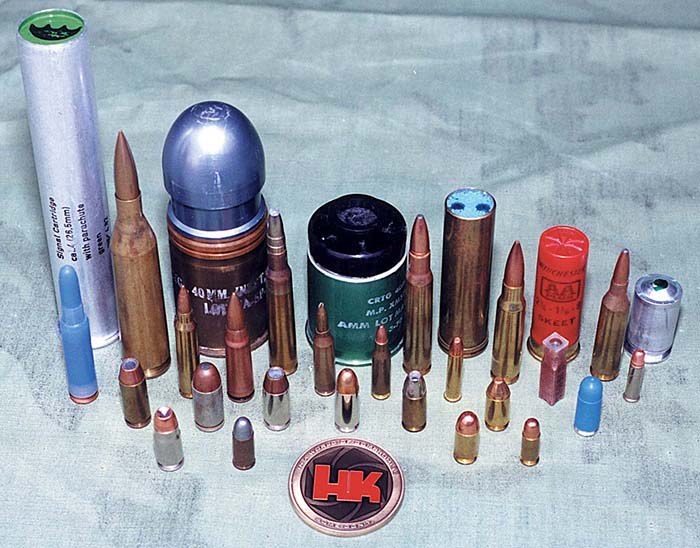
Everything but the kitchen sink
Currently HK produces more than 250 different models of HK firearms, not including the many variants of each. While each HK firearm may not be at the very top of each customer’s shopping list in every category (many are), they all come fairly close at being the best available anywhere. No other manufacturer in the world can completely outfit a military unit for instance with the complete array of small arms as Heckler & Koch can and has on many occasions. It is also safe to say that HK leads the entire industry currently in the development of new small arms designs, many that the world has seen in the past five years and far more that will emerge in the next five years.
In addition to firearms, HK produces many of its own accessories, including mounts and tripods for machine guns and ball socket firing ports for pistols and submachine guns that allow the shooter to fire through vehicle windows. Heckler & Koch still produces barrels, bolts and belt drums for the 7.62mm MG3 machine gun still serving in the German military and the firing mechanisms for the Panzerfaust 3 and Armbrust rocket launchers. HK has designed flame-throwers, road spikes, specialized 40mm less-than-lethal projectiles, visible and IR laser aimers and lights, gas grenade launchers and special weapons designed for use underwater. In fact HK has designed and produced items totally unrelated to small arms, items such as the linkless feed system for the Eurofighter aircraft and even an airbag deployment system using the caseless ammunition propellant developed for the G11 rifle.
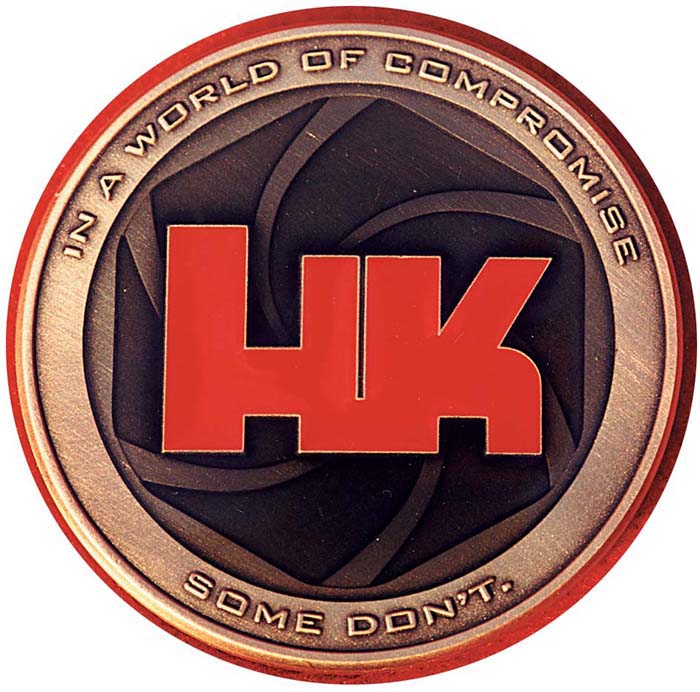
Until only a few years ago HK designed and produced its own high precision multiple station CNC milling, drilling and grinding machines and computers to drive them in a separate company called Hekoma. HK even had a division that specialized in the custom design and fabrication of advanced indoor and outdoor shooting ranges for law enforcement and military organizations the world over, to include a few here in the United States. HK has run for years a training school for apprentice technicians in its Oberndorf hometown.
HK has set up for the host country production facilities in 13 locations around the world as “turn-key” operations for internal military and/or law enforcement use. HK weapons, to include rifles, submachine guns, machine guns and handguns have been and in some cases are still being produced in these licensed facilities in Turkey, Greece, Pakistan, Saudi Arabia, Mexico, Columbia, the U.K., and other countries. HK’s users list is like a who’s who of military, law enforcement and special operations organizations. It is safe to say that HK weapons are in use in nearly every country in the world.
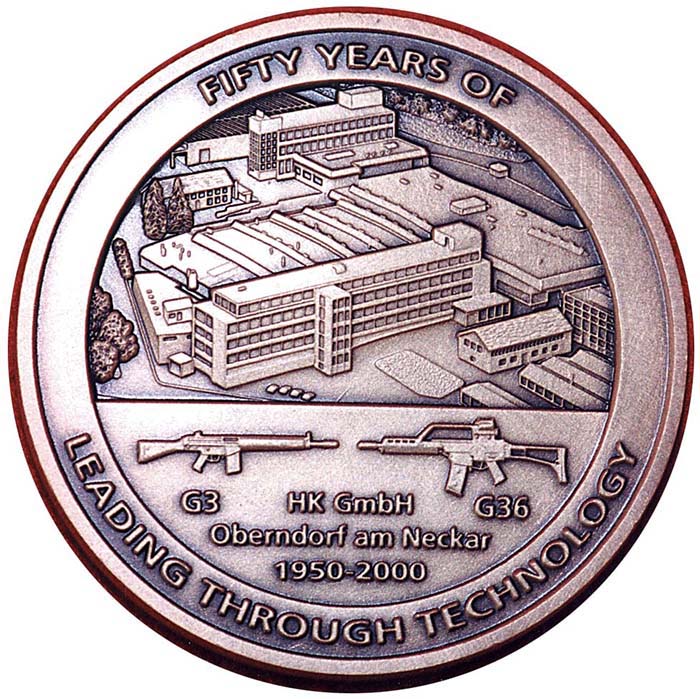
Leading through Technology, Innovation and a “No Compromise” attitude
HK has constantly pushed the envelope of small arms, ammunition and materials technology by challenging its design department to create some of the world’s most unique if not deadly shoulder fired weapons. While many of these HK small arms marvels never entered series production, in most cases this was not due to a lack of promise offered in their design and performance and was more as a result of the lack of funding or changes in user requirements. The caseless ammunition firing G11 rifle offered a huge increase in combat capability over existing assault rifles allowing the soldier the means to carry three times the ammunition compared to that of a soldier armed with a 7.62mm rifle like the HK G3. Fully loaded with three 45-round magazines the G11K3 weighed just over 10-pounds and fired at an amazing 2,200 rounds per minute when firing in the 3-round burst mode. The G11 was not adopted by the German armed forces for political reasons related to the end of the Cold War.
The HK CAWS (Close Assault Weapon System) developed in the 1980’s in conjunction with Olin Winchester was the most awesome “combat shotgun” ever devised. Firing 8 tungsten-alloy OO buck pellets or a compliment of steel flechettes from a 3-inch brass belted magnum case the CAW could perforate both sides of a 5-ton military truck at ranges beyond 100 meters. The select-fire CAW fired from a 10-round box magazine and would have been a defender’s weapon of choice for distances out to 150 meters against aggressors protected by body armor or in lightly armored vehicles. More gun that the users wanted, the HK CAW tested well but never entered production.
An HK long-range rifle system that also never progressed into production known as the WSG2000 could propel a 340 grain projectile to man sized targets at ranges out to 2,000 meters with pinpoint accuracy. It’s full-solution fire control system was designed to remove 90% of the aiming error caused by the effects of range to the target, the effects of weather and those produced by the shooter. The WSG2000 died when the funding and user requirements changed.
The HK36 rifle in caliber 4.6X36mm, developed in the early 1970’s, weighed just 8.1 pounds loaded with 90 rounds of the newly developed 4.6X36mm round loaded with the deadly 42-grain bullet with beveled “spooned nosed” tip. The HK36 was a modern assault rifle that was never produced because of the political ramifications of a German firm offering such a deadly assault rifle/ammunition combination so soon after the close of World War II.
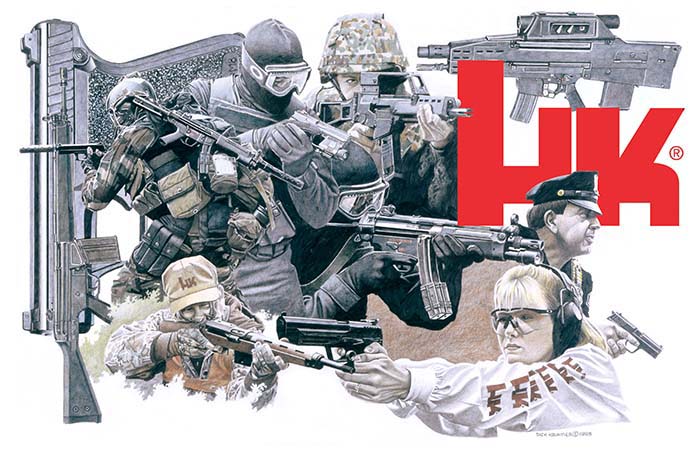
HK’s of the 21st Century
The new century promises to bring a host of new and innovative products out of the design and production departments at HK. In the personal weapons category, a smaller reincarnation of the lethal HK36 4.6X36mm round in a 30mm length was recently announced by HK for use in their new Personal Defense Weapon (PDW). Weighing in at just 2.6 pounds loaded with 20 rounds in the pistol grip, the PDW can be fired with one hand or from the shoulder using a slide-out shoulder stock and fold down vertical foregrip. With the capabilities of a 5.56mm carbine out to 250 meters, but in a package comparable in size and weight to a large handgun, the new HK PDW redefines the state-of-the-art for personal firepower for the 21st century.
HK’s latest small arms marvel is the Objective Individual Combat Weapon (OICW) that fires air-bursting 20mm grenades out to 1,000 meters and allows the combatant to engage targets behind cover, for the first time in the history of the infantryman. Using a ballistic computer and laser range finder combined with titanium barrels and a unique recoil mitigation system, the OICW promises to raise the bar in the field of small arms development and combat capability for the next century with the first U.S. combat units equipped in 2006.
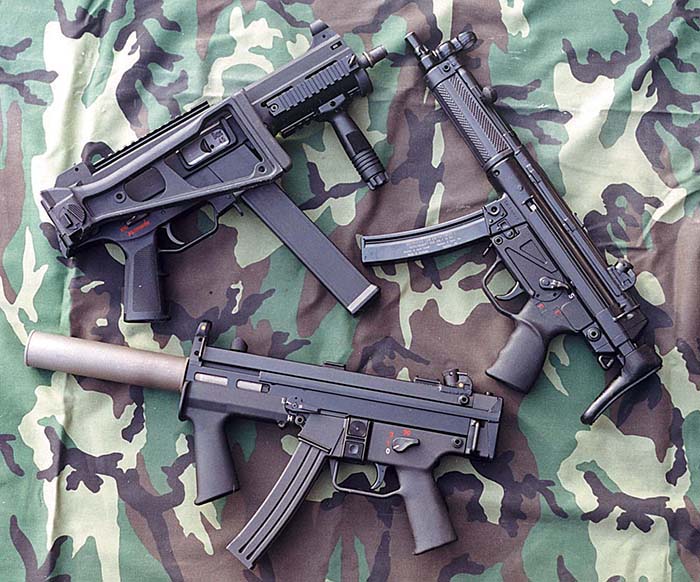
The Submachine Guns
HK is probably best known in the American market for the famed MP5 submachine gun as a result of the weapon being used by the world’s most elite counter terrorist organizations, such as Germany’s own GSG9 and the British Special Air Service (SAS). Nearly every elite military unit in the world, and most law enforcement organizations in the United States have or still employ at least one version of the MP5 for close in defensive and offensive applications. Known internally at HK as the HK54, the “Machine Pistole 5” is still in series production after three decades, and while not the world’s most prolific submachine gun by sheer numbers, the MP5 is widely considered as the world’s finest and most capable submachine gun.
The first MP5 in caliber 9mm Parabellum was produced in 1965. More or less a downscaled version of the G3 assault rifle, the 9mm MP5 has progressed through countless iterations in the past 35 years. The basic unsuppressed MP5A2 with fixed plastic buttstock was closely followed by the retractable stocked MP5A3 version. In 1974 the integrally suppressed MP5SD provided the user with sound suppressed fire using standard supersonic ammunition. The third model in the MP5 family is shorty, officially known as the MP5K, K meaning Kurz or short in the German language, and appeared on the scene in 1976. The latest and last model of the MP5 first produced in 1992 are those rarely seen outside of the United States and chambered for the .40 S&W and 10 mm Auto cartridges, namely the MP5/40 and MP5/10. As is the case with almost every category of HK firearms, pistols, rifles, machine guns, etc., many variants of these four models exist and in almost every and any possible configuration. Like a gun built with a Lego building block set, seldom do two MP5’s look identical.
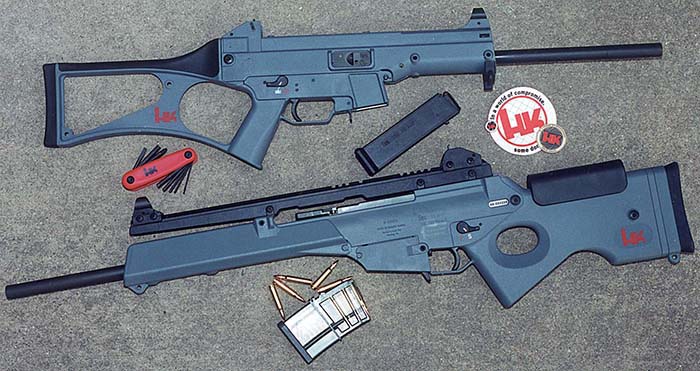
In addition to the MP5 sub gun, since 1982 HK has quietly been developing a totally new pistol-caliber “machine pistol”. Not intended as a replacement for the MP5, the new submachine gun was originally developed for the US military as the SMG under a JSSAP R&D contract. After successful user testing, “the community” decided to purchase the series production MP5 and the SMG Program was shelved, but not within the design department of HK. Seeing the advantage of using polymer materials in the weapon’s design, HK refined the SMG into a never produced prototype called the MP2000, one gun that would do all the jobs currently performed by the then three models of the 9mm MP5. In the end after some additional years of development and testing, HK unveiled the 4.5-pound UMP (Universal Machine Pistole) in caliber .45 ACP in 1999. Later that same year the UMP was also released in caliber .40 S&W to replace the discontinued MP5/40.
Handguns
HK has had a long tradition of developing handguns for nearly every imaginable purpose, from the sub-combat caliber-convertible HK4 pistol first produced in 1962 for the German police, to the relatively large and sometimes referred to as massive USSOCOM MK23 Offensive Handgun delivered to the U.S. Navy SEAL’s in 1996. As a general statement about HK’s family of handguns one word comes to mind — different. With the exception of the USP and MK23 no two HK pistol models are even remotely alike. The operation and design of the HK4 compared to that of the VP70 “Volks-Pistole”, the roller-locked P9S and the gas-retarded P7 series of handguns are radically different and certainly share little in common with the exception of their source of origin. Only the more recent HK pistols, the USP and MK23, share common technology, materials, features and manual of arms.
As of 1999 HK still produces the 9mm Parabellum P7 family (PSP, P7M8, P7M13) and all versions of the USP and MK23 and even the single shot P2A1 and 5-shot EFL flare pistols. The earlier pistol designs have since been discontinued in favor of the more conventional, more affordable and more successful in terms of units sold, USP series which first appeared on the worldwide market in the early 1990’s.

The HK handguns have been historically innovative. The HK4 could be converted by the operator into any one of four calibers (.22 LR, .25 Auto, .32 ACP, .380 Auto) using simple tools supplied with the conversion kits. The VP70, designed in 1973, was intended to be a pistol for the people, or “Volks-Pistole”, thus the origin of the “VP” in the pistol’s acronym. Intended to be simple to operate and maintain and inexpensive to produce, the VP70 is considered by many to be the predecessor of the enormously popular and extensive Glock pistol family. With an 18-round 9mm magazine, DA Only trigger system, polymer frame, the first of it’s kind in the industry, striker firing mechanism and durable finish, the HK VP70 set the trend for features that would be common in many of the pistol designs that would appear throughout the industry decades later. An interesting M version of the VP70 could be fitted with a plastic shoulder stock and fired in 3-round burst mode at an incredible rate of 2,000 rounds per minute, a true machine pistol in keeping with the proper definition for such a beast. A limited number of VP70’s were also produced in 9X21mm for the Italian market.
In keeping with the HK Weapons System protocol, the roller-locked P9S was considered clearly an extension of the long guns into the handgun category using the operating and breech locking principle of the HK assault rifles and submachine guns. The P9S was available in combat (fixed sights), target (adjustable sights and trigger stop) and competition or “Sport” model with extended barrel and barrel weight, in both 9mm and .45 calibers. A never produced prototype P9K, 1/2 inch shorter than the standard P9S was also created as were prototype select-fire models with buttstock, sound suppressed model (P9SSD) and models in calibers .25 Auto, .380 Auto, .22 LR and even 9X18mm Ultra.
Few readers are not familiar with the HK USP and MK23 handguns. Sharing common and conventional operating characteristics, the two pistol designs utilize the latest in injection polymer molding technology spawned 30 years earlier with the HK VP70 pistol. The USP and to a lesser degree the .45 ACP MK23/Mark 23 handguns have faired well in the competitive world-wide handgun market against pistols priced considerably less. The full-size 9mm USP is the standard issue service pistol for the German military (P8) replacing the aged P1 pistol. The HK P10, a compact USP9 pistol also in caliber 9mm Parabellum, was recently selected as the new German police pistol.
Rifles
HK has produced some of the finest rifles found anywhere in the world. Assault rifles and carbines, sniper rifles, paramilitary rifles and even a complete line of wood stocked hunting rifles. Until recently all HK rifles employed some variation of the blowback operated delayed roller-locked bolt system first pioneered in the G3 rifle. HK rifles have been produced with barrel lengths ranging from the 8.3 inch barrel of the HK53 rifle- caliber “submachine gun” to that of the PSG1 sniper rifles at over 25 inches. HK rifles, namely the hunting rifles, have been chambered in most popular sporting cartridges to include .22 LR, .22 WMR, .223 Remington, .243 and .308 Winchester rounds and .30-06 Springfield. Let’s not forget the HK32 assault rifle chambered in caliber 7.62X39 mm Russian and the HK940 hunting rifle in 7X64mm Brenneke. Developmental rifles never produced were also chambered for unique cartridges like the 4.73X33mm caseless round of the G11, the 4.6X36mm HK36 round and a long-range cartridge known as the 9X90mm MEN. The 9X90 MEN was essentially a necked down .50 BMG cartridge firing a 340 grain 9mm bullet for the HK long-range sniper rifle design never produced termed the WSG2000.
Most Americans know the HK line of rifles from their exposure to the well known HK 90 series rifles comprised of the HK91, HK93, HK94 and along the same lines the SP89, actually a pistol but based on the MP5K submachine gun. The 90 series rifles remain popular today even though they were banned from further importation to the U.S. in 1989 by the Bush administration. Many unlicensed copies exist, most notably those that are modeled after the semi-automatic HK91 rifle. HK rifles are known for their extreme reliability and durability, excellent accuracy and modularity allowing interchangeability of parts and assembly groups, like all HK firearms, without the need for hand fitting. Original HK 90 series rifles now sell on the open market for well over $2,000, the HK94 approaching $4,000 or more.

The latest rifle system from HK, the G36, is also probably its finest. Lightweight and inexpensive the G36 combines low recoil with minimal fouling into a complete package that addresses all of the drawbacks of earlier HK rifles. The G36 is now the standard 5.56mm assault rifle of the German military and more recently the Spanish Army and has done very well in the current very competitive and shrinking world market for assault rifles. The SL8-1, a semi-auto version of the G36, has recently been offered for retail sale in the United States.
For extreme accuracy from an auto-loading rifle, the HK PSG1 is still considered today as the preeminent precision “sniper” rifle in the world. Produced since 1974 the PSG1 has seen service the world over in the hands of expert marksman from military units and law enforcement tactical teams. The PSG1, now banned in the U.S. for retail sale, also has the unenviable reputation as being one of the world’s most expensive rifles. Capable of 5 shot groups measuring under 1/2 inches at 100 meters the PSG1, like most HK firearms, in the right hands excels in its intended role.
Machine Guns, Grenade Launchers and Shotguns
In the area of belt-fed machine guns few modern guns match the capabilities of the HK21E machine gun. A direct descendent of the 7.62X51mm NATO G3 rifle, the HK21E weighs only 18 1/2 pounds and is capable of sustained fire at a cyclic rate of approximately 900 rounds. The HK21E and its 5.56mm cousin, the HK23E, are actually the same weapon with different components. This makes it possible for the operator in the field to convert an HK21E to caliber 5.56X45mm NATO and even 7.62X39mm Russian and from belt feed to box magazine or drum feed with no special tools required. Renowned for the precision accuracy and utter reliability, the HK21E and its variants are often the choice of the world’s most elite units when the hard-hitting firepower of a 7.62mm belt fed machine gun is required in a relatively lightweight package that can stand up to hard use and abuse that these units are famous for.
HK has produced single-shot grenade launchers firing the low pressure 40X46mm grenades also used in the U.S. M79 and M203 launchers, both standalone shoulder fired versions like the HK69A1 and add-on models such as the HK79A1 that fit on the HK G3, HK33 and out of production G41 assault rifles. A new lightweight aluminum launcher for the G36 rifle called the AG36 is nearly complete as is the belt-fed 40X53mm HK Grenade Machine Gun (GMG) expected to enter service with the German military early in this new century. Capable of firing 350 high explosive grenades per minute out to 2,200 meters, the HK GMG weighs only 57 pounds, a full 21 pounds lighter than the current U.S issue automatic grenade launcher, the MK19.
HK has actually never produced its own 12-gauge shotgun, with the exception of prototypes such as the HK CAWS described earlier. However, HK’s name has been placed on as many as three single shot and semi-automatic shotguns, such as the well respected model HK512, produced exclusively for HK by Franchi and issued to elite German anti-terrorist units.
The Future
The future is now. What the next 50 years will hold for Heckler & Koch is anyone’s guess. The world’s small arms market is shrinking as a result of the end of the Cold War, the resulting shrinking defense budgets and the additional competition for small arms sales from former Eastern Block and third world manufacturers from around the globe. Unlike many struggling arms makers in the world, HK has continually reinvested in its future, in its employees, production facility, methods and capabilities and in new products, a key to survival in any competitive international industry.
One thing is clear. No matter what happens in the volatile world small arms market, Heckler & Koch will continue to follow its motto of “Leading Through Technology”.
| This article first appeared in Small Arms Review V3N12 (September 2000) |



